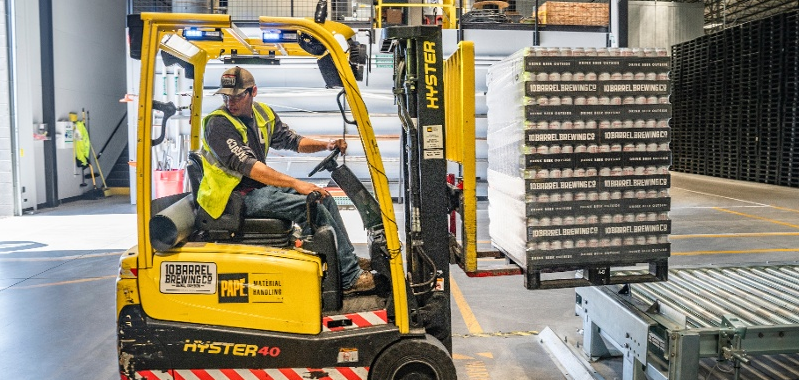In Part 1 of this series, we talked about controlling inventory, before being able to competently manage inventory. Now, let’s talk about some other best practices.
More about best practices in Organization
 Correct part numbers and labeling – Mislabeled SKUs in your warehouse are worse than useless. They can lead to other problems like incorrect picking and shipping of items, angry customers and customer returns. Whenever a mislabeled SKU is identified, insofar as is possible, the history of the item should be tracked back in order to identify the cause of the mislabeling. Did the vendor ship the wrong item? Did purchasing order the wrong item? Was it received incorrectly? Root-causes should be charted, Pareto analyzed and systematically attacked in order to reduce occurrences of such instances.
Correct part numbers and labeling – Mislabeled SKUs in your warehouse are worse than useless. They can lead to other problems like incorrect picking and shipping of items, angry customers and customer returns. Whenever a mislabeled SKU is identified, insofar as is possible, the history of the item should be tracked back in order to identify the cause of the mislabeling. Did the vendor ship the wrong item? Did purchasing order the wrong item? Was it received incorrectly? Root-causes should be charted, Pareto analyzed and systematically attacked in order to reduce occurrences of such instances.
 Organize your warehouse locations – I once went into a large warehouse, looked around, and asked the warehouse manager: “How did you decide where to place your items in relationship to one another?” He looked at me with a self-satisfied smile and said, “I looked at the way Walmart stores organized their products on the shelves and followed their example. That way, my guys know just which sections to go to in order to pick each kind of product. They’re all together!”
Organize your warehouse locations – I once went into a large warehouse, looked around, and asked the warehouse manager: “How did you decide where to place your items in relationship to one another?” He looked at me with a self-satisfied smile and said, “I looked at the way Walmart stores organized their products on the shelves and followed their example. That way, my guys know just which sections to go to in order to pick each kind of product. They’re all together!” I explained: “What’s good for Walmart and consumers, is not necessarily good for a fast-paced warehouse.” I went on to explain the problem. If you put a lot of items side by side in your warehouse that look very similar, you increase the possibility that a picker might select the wrong item. If Widget Type A looks almost identical to Widget Type B, but they have crucial differences in application or performance, you do not want to have these two items side by side in your warehouse. You want to have the separated from one another so a picker in a rush doesn’t grab the wrong item out of the bin.
I explained: “What’s good for Walmart and consumers, is not necessarily good for a fast-paced warehouse.” I went on to explain the problem. If you put a lot of items side by side in your warehouse that look very similar, you increase the possibility that a picker might select the wrong item. If Widget Type A looks almost identical to Widget Type B, but they have crucial differences in application or performance, you do not want to have these two items side by side in your warehouse. You want to have the separated from one another so a picker in a rush doesn’t grab the wrong item out of the bin.
A consumer that picks up the wrong can of soup, or wrong flavor of toothpaste from a Walmart shelf has no one to blame but himself. But, a customer of your operation that receives Widget Type A, when what she really needs is Widget Type B, is likely to be quite unhappy—and will properly blame your operations.
 Organize for speed and efficiency – Another reason you shouldn’t organize your warehouse like Walmart organizes its products is that there may be vast differences in SKU hit rates. In a warehouse, you want to have your high hit-rates near the front of your warehouse, within easy reach of your pickers. Hit-rate is the number of times an item must be picked and may not correlate with quantity picked. For example, a SKU that requires pickers to fetch a quantity of one or more a thousand times a month may sell at a lower volume than an item that requires pickers to fetch quantities from the bin only three times a month, but in large quantities each time. You want the former item—the one requiring a thousand trips to the bin by the pickers—near the front of your warehouse. The other SKU is not so important to be in easy reach. The pickers only need to go to the bin about three times a month.
Organize for speed and efficiency – Another reason you shouldn’t organize your warehouse like Walmart organizes its products is that there may be vast differences in SKU hit rates. In a warehouse, you want to have your high hit-rates near the front of your warehouse, within easy reach of your pickers. Hit-rate is the number of times an item must be picked and may not correlate with quantity picked. For example, a SKU that requires pickers to fetch a quantity of one or more a thousand times a month may sell at a lower volume than an item that requires pickers to fetch quantities from the bin only three times a month, but in large quantities each time. You want the former item—the one requiring a thousand trips to the bin by the pickers—near the front of your warehouse. The other SKU is not so important to be in easy reach. The pickers only need to go to the bin about three times a month.
Look for Part 3 in this series for even more best practices for you to consider and implement.
Think about it. Leave your comments below, or feel free to contact us directly, if you prefer.
Follow us on Twitter: @RKLeSolutions and @RDCushing
LIKE us on Facebook: RKL eSolutions and GeeWhiz2ROI




